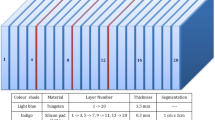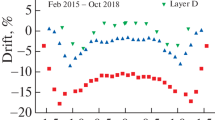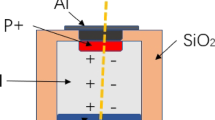Abstract
The High Granularity Calorimeter (HGCAL) is the technology choice of the CMS collaboration for the endcap calorimetry upgrade planned to cope with the harsh radiation and pileup environment at the High-Luminosity LHC. The HGCAL is realized as a sampling calorimeter, including an electromagnetic compartment comprising 28 layers of silicon pad detectors. Prototype modules, based on hexagonal silicon pad sensors have been constructed and tested in beams at FNAL and at CERN. We present the construction and first beam-tests of these modules both in the laboratory and with beams of electrons, pions and protons, including noise performance, calibration with minimum ionizing particles, electron relative energy and position resolutions and precision-timing measurements.
Access provided by CONRICYT-eBooks. Download conference paper PDF
Similar content being viewed by others
1 Introduction
The CMS collaboration will replace its current endcap calorimeters with a silicon-based High Granularity Calorimeter (HGCAL) for the High-Luminosity LHC era, in order to sustain the high radiation and guarantee excellent-quality object reconstruction and identification in the dense pileup environment. The HGCAL is a sampling calorimeter that includes both electromagnetic (lead absorber and hexagonal silicon sensors) and hadronic (stainless steel absorber and silicon or scintillators detectors) sections. More details on HGCAL detector and the motivations for building it can be found in [5]. We discuss the construction and first beam-tests of silicon-tungsten prototype modules and the beam-test of irradiated and unirradiated diodes performed in 2016. The aim is to validate the HGCAL design concept based on silicon sensors, whilst evaluating their performance and comparing them with a detailed simulation.
2 Experimental Setup for the Study of Silicon-Tungsten Modules
In this section, we describe the silicon sensors used and the corresponding module assembly, the data acquisition system, and the data-taking setup and conditions for the beam tests of part of the electromagnetic section of the HGCAL.
2.1 Silicon Sensors and Module Assembly
The used silicon sensors are n-type with a physical (depleted) thickness of 320 (200) \(\upmu \)m. Each hexagonal silicon sensor, cut from 6” wafers, has 128 readout cells. Most of these cells are 1.1 cm\(^{2}\) in size and are hexagonal in shape, except for two central cells used for calibration that have 1/9 of the standard size, and some cells around the edges that have variable size and shape. Figure 1a shows an example of such a module and Fig. 1b the module assembly. Each module has a copper-tungsten (25%Cu:75%W) hexagonal baseplate with coefficient of thermal expansion close to that of silicon. The baseplate provides mechanical rigidity to the module and is part of the calorimeter absorber. It is glued, using Araldite 2011 non-conductive epoxy, to a polyimide gold-surfaced sheet, which allows for the biasing of the back side of the silicon sensor. The polyimide foil is then glued to the sensor itself and the sensor to a first PCB, which connects electrically to the front side of the silicon cells with aluminium wire bonds through holes in the PCB and routes these signals to two small connectors. A second “readout PCB”, connected to the first, contains the front-end electronics and connectors to the outside world. An existing ASIC has been used: the “Skiroc2” [2] developed for the CALICE collaboration [4]. Each Skiroc2 has 64 channels, with each channel having a preamplifier and two separate slow shapers (with gain ratio 10:1), a fast shaper, self-trigger and fifteen-cell pipeline, as well as a 12-bit ADC. Only the slow shapers were used in our system, since we utilized an external trigger, while the fast shaper is used for self-trigger. Two Skiroc2 ASICs were mounted on each readout PCB.
2.2 Data Acquisition System
Figure 2a shows a photograph of the full DAQ chain, which uses commercial components mounted on custom PCBs. The data from the Skiroc2s are first transferred from the module to an intermediate “elbow board”, which provides the bias voltage (operation voltage of the sensors is 120 V), and then moved to a dual daughterboard carrier (DDC) card through polyimide cables. These DDC hosts two “FMCIO” mezzanines, utilizing standard FMC connectors and incorporating Xilinx XC7A100T “Artix” FPGAs, and routes the signals from two FMCIO (hence two modules) to a standard HDMI connector. The “Zedboard” then accumulates data through another passive custom board, known as the “ZEDIO”. The final link is from the Zedboard to a standard PC via ethernet.
2.3 Data Taking at FNAL and CERN
The data taking at FNAL and CERN has been carried out with 3 configurations.
At FNAL, 16 modules were available, arranged as double-sided layers interspersed with tungsten absorbers, for a total thickness of about 15 \(X_0\), as shown in Fig. 2b. Electrons with energies in the range [4–32] GeV and protons with energies of 120 GeV were used. A single 2\(\,\times \,\)2 cm\(^{2}\) scintillator was used as a trigger, as readout devices in coincidence.
At CERN, 8 modules were used in 2 schemes: “CERN setup I”, having the modules placed between about 6 \(X_0\) and 15 \(X_0\), and “CERN setup II”, shown in Fig. 2c, with modules covering from 5 \(X_0\) to 27 \(X_0\). Electrons with energies in the range [20–250] GeV and pions with energies of 125 or muons decaying from pions of 120 GeV were used. The trigger was based on two consecutive scintillators in coincidence, with the one closest to the detector defining the trigger size of 4\(\,\times \,\)4 cm\(^{2}\).
The various setups described in the previously are simulated with GEANT4 [6], using the FTFP_BERT_EMM (the default one used in CMS [3]) and QGSP_FTFP_BERT physics lists.
3 Performance of Silicon-Tungsten Modules
In this section, we summarize the results of the measurements related to the properties of the silicon-tungsten modules described in Sect. 2.
The raw information provided as input from the DAQ is processed through a dedicated analysis framework implemented in the standard CMS software. The energy deposited in each cell is calibrated in terms of minimum ionizing particle, “MIP”, as follows. First, the pedestal and a common mode noise, found in the cells of the modules when the bias voltage is applied, are subtracted from the ADC count (the pedestal RMS and noise RMS are found to be stable within 2 ADC counts). Then, the corrected ADC counts are converted to MIPs using the single-particle response curves in a cell of the detector originated from proton (FNAL) and pion or muon (CERN) beams. Since proton and pion at the energies mentioned are not strictly minimum ionizing, the obtained single particle response was suitably corrected using inputs from simulation. 1 MIP is found to be approximately 17 ADC counts, from the calibration on the cells of sensors within the trigger area.
3.1 Transverse and Longitudinal Shower Shapes
Figure 3a illustrates an example of the energy deposit from an electron crossing a hexagonal module. The red cell represents the cell with the highest energy release, \(E_1\), while the orange (green) ones the 6 (12) cells in the first (second) ring around it, so that \(E_7\) (\(E_{19}\)) is the energy sum in these cells and the ones inside them. From these cells some quantities can be defined to study the transverse profile, such as the \(E_1/E_7\) ratio, which is displayed in Fig. 3b.
The longitudinal shower barycentre is instead defined as \(t = \frac{ {\sum _{i=1}^{8}}\left( E_{i} X_{0,i} \right) }{ {\sum _{i=1}^{8}} E_{i} }\), where \(E_i\) is the layer energy and \(X_{0,i}\) the total calorimetric radiation length up to layer i, and is illustrated in Fig. 3c.
These two examples for studying the transverse and longitudinal electron shower profiles show a very good agreement between the data and the simulation.
3.2 Energy Measurement and Resolution
The energy of showering electrons is reconstructed from the sum of the individual energies, exceeding a threshold of 2 MIP, deposited in all the cells and the modules. This quantity, which represents only the energy released in the active layers, is combined with sampling factors reflecting the dE/dX for MIPs in the absorbers to give the final energy measurement.
The cores of the obtained energy distributions are fitted with Gaussian functions and the resulting mean and \(\sigma \) values are taken as the mean energy response and the energy resolution of the detector. Figure 4a shows the relative energy resolution as a function of the beam energy for both data and simulation. The FNAL and CERN setup II configurations are displayed on the same canvas to emphasize the different sampling regimes of the two setups. An energy resolution below about 7%, for an electron energy > 50 GeV, can be achieved. We can see that the limited longitudinal samplings clearly limit the possible electron energy resolution that is achievable but that the simulation matches the data at the 5% level for all the studied energies.
(a) Relative energy resolution as a function of the electron energy. (b) Residual widths of the X-coordinate reconstruction on the first sensitive layer as a function of incident electron energy. (c) The intrinsic precision of the HGCAL sensors X-coordinate measurement for all layers and for all energies. From CMS-CR-2017-169. Published with permission by CERN.
3.3 Position Measurement and Resolution
The position is measured as the difference between the track position, extrapolated from two wire chambers upstream of first HGCAL module, and the electron shower position, taken as the logarithmic weight of the energy deposited in the \(E_{19}\) cluster, using CERN setup I. The width of the distribution of this residual is considered as the position resolution of a given sensor.
Figure 4b shows the X-coordinate resolution on the first sensitive layer as a function of incident electron energy. Figure 4c shows the intrinsic precision of the HGCAL sensors’ X-coordinate measurement for all layers and for all energies. A precision of a few millimeters can be achieved, which increases with energy and decreases with depth in calorimeter. A good agreement between data and simulation is found.
4 Precision-Timing with Silicon Diodes
This measurement is performed on sets of 5\(\,\times \,\)5 mm\(^{2}\) silicon diodes of different types (p-on-n and n-on-p) and thicknesses, previously irradiated to a range of neutron fluences representative of those expected in the HGCAL. The experimental setup, shown in Fig. 5a, consists of 3 sets of 6 diodes (2 non irradiated and 4 irradiated) interspersed with lead absorbers. The irradiated diodes were operated at 600 and 800 V, while the non-irradiated ones at 600 V only. Data were taken with electron beams of 100 and 150 GeV for p-type and n-type diodes.
The pulse from each diode was digitized at 5 GHz and the pulse amplitude and timing information were extracted on an event-by-event basis, following the same procedure as in [7]. To estimate the timing capabilities of these devices, the timing measured by each diode is compared to that of an unirradiated diode of the same thickness and type. The distributions of the time differences are fitted with a Gaussian function.
In Figs. 5b, c the resolution on the time difference between an unirradiated and an irradiated diode is shown for p-type, n-type diodes of 300 \(\upmu \)m thick, as a function of the effective S/N, given by \((S/N)_{eff} = \frac{(S/N)_{ref} (S/N)_n}{\sqrt{(S/N)_{ref}^2 + (S/N)_n^2}}\), “ref” being the reference diode and “n” the diode used for the difference. The plots show that it is possible to achieve a 20 ps timing resolution for reasonably large signals and that there is no degradation in performance at different fluences.
(a) Layout of the experimental setup for precision-timing measurement of irradiated and unirradiated diodes. (b), (c) Resolution on the time difference between an unirradiated and an irradiated diode as a function of \((S/N)_{eff}\), shown for the 300 \(\upmu \)m thick diodes of p-type (b) and n-type (c). From CMS-CR-2017-169. Published with permission by CERN.
5 Summary and Outlook
The HGCAL is the CMS subdetector chosen for replacing its current endcap in the High-Luminosity era. A proof of concept of this new calorimeter has been obtained through the construction and first beam-tests in 2016 of the silicon-absorber modules that form the basis of the electromagnetic section of the HGCAL calorimeter and the beam-test with diodes. The measurements show that it is possible to achieve a relative energy and a position resolution below \(\sim \)7% and \(\sim \)2 mm, for electrons with energy greater than 50 GeV, and a timing resolution of \(\sim \)20 ps for different radiation levels and at modest values of \((S/N)_{eff}\). The comparison with the simulation shows a good agreement of the measurement with respect to the data, giving credence to its accuracy and scalability. In 2017, the beam-tests plan foresees the study of silicon modules with an updated front-end chip (“Skiroc2-CMS” [1]) with the capability to process time information and including a configuration that can be representative of the hadronic sections of HGCAL as well.
References
Cokoc, S., Dulucqa, D., de La Taillea, F., Rauxa, C., Sculacc, L., Borg, T., Calliera, J., Thienpon, D.: SKIROC2 CMS an ASIC for testing CMS HGCAL. J. Instrum. 12(02), C02019 (2017)
Callier, S., Dulucq, F., de La Taille, C., Martin-Chassard, G., Seguin-Moreau, N.: SKIROC2, front end chip designed to readout the electromagnetic CALorimeter at the ILC. J. Instrum. 6(12), C12040 (2011)
CMS Collaboration The CMS experiment at the CERN LHC. JINST 3, S08004 (2008)
The CALICE collaboration: Construction and commissioning of the CALICE analog hadron calorimeter prototype. JINST 5, P05004 (2010)
Contardo, D., Klute, M., Mans, J., Silvestris, L., Butler, J.: Technical Proposal for the Phase-II Upgrade of the CMS Detector. Technical report CERN-LHCC-2015-010. LHCC-P-008. CMS-TDR-15-02, Geneva, June 2015
GEANT4 Collaboration: Geant4 - a simulation toolkit. Nucl. Instrum. Meth. A 506, 250 (2003)
Akchurin, N., et al.: On the timing performance of thin planar silicon sensors. Submitted to Nuclear Instruments and Methods (2016)
Author information
Authors and Affiliations
Consortia
Corresponding author
Editor information
Editors and Affiliations
Rights and permissions
Copyright information
© 2018 Springer Nature Singapore Pte Ltd.
About this paper
Cite this paper
Romeo, F., On behalf of the CMS collaboration. (2018). Construction and First Beam-Tests of Silicon-Tungsten Prototype Modules for the CMS High Granularity Calorimeter for HL-LHC. In: Liu, ZA. (eds) Proceedings of International Conference on Technology and Instrumentation in Particle Physics 2017. TIPP 2017. Springer Proceedings in Physics, vol 213. Springer, Singapore. https://doi.org/10.1007/978-981-13-1316-5_9
Download citation
DOI: https://doi.org/10.1007/978-981-13-1316-5_9
Published:
Publisher Name: Springer, Singapore
Print ISBN: 978-981-13-1315-8
Online ISBN: 978-981-13-1316-5
eBook Packages: Physics and AstronomyPhysics and Astronomy (R0)









